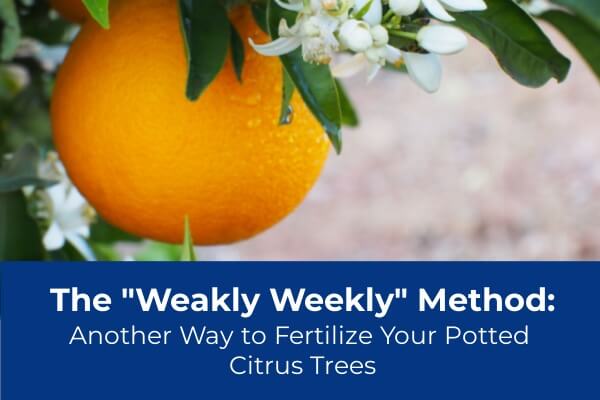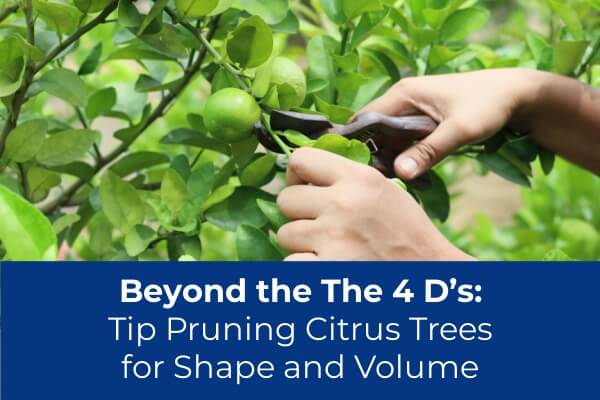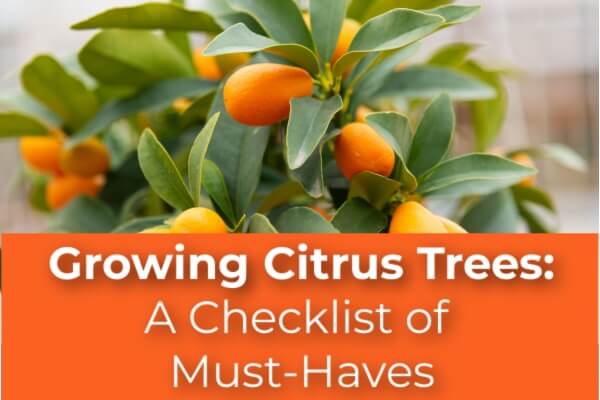The "Weakly Weekly" Method: Another Way to Fertilize Your Potted Citrus Trees
Growing citrus trees appeal to all of our senses. I would say that their visual beauty, gorgeous scent and flavorful fruit make them a triple threat of the fruit tree world. However, to keep them thriving in containers, proper fertilization is essential if you want them to reach their fullest potential. One of the best approaches for feeding potted citrus trees during the active growing seasons of spring and summer is the "weakly weekly" method. This technique, popularized by Farmer Fred Hoffman ensures consistent nourishment while preventing nutrient overload, which is crucial for container-grown citrus.
Why Potted Citrus Trees Need Special Fertilization
Unlike citrus trees planted in the ground, potted citrus trees have limited access to nutrients. Their roots are confined to a small space, meaning they rely entirely on the soil and fertilizer provided by you, the grower. Over time, nutrients in potting soil get depleted, and regular feeding is necessary to sustain growth and fruit production.
Fertilizing potted citrus trees incorrectly can lead to issues such as:
- Over-fertilization: Too much fertilizer can cause salt buildup in the soil, leading to root damage and leaf burn.
- Nutrient Deficiencies: Inconsistent or inadequate feeding can cause yellowing leaves, poor fruit set, and stunted growth.
- Unbalanced Growth: High doses of fertilizer all at once can lead to excessive leafy growth at the expense of flowers and fruit.
The "weakly weekly" method addresses these concerns by providing a steady supply of nutrients without overwhelming the plant.
What Is the "Weakly Weekly" Fertilization Method?
The "weakly weekly" method involves diluting fertilizer to half strength and applying it every 7-10 days instead of using full-strength fertilizer once a month. This approach mimics the natural, slow release of nutrients that in-ground trees receive and helps potted citrus trees absorb nutrients more effectively.
Why This Method Works So Well
- Prevents Nutrient Shock: Instead of bombarding your citrus tree with a heavy dose of fertilizer, it receives a gentle, consistent supply of nutrients.
- Encourages Steady Growth: Regular feeding supports continuous leaf, flower, and fruit development.
- Reduces Salt Buildup: Over time, excess fertilizer salts can accumulate in container soil, which can damage roots. Frequent light feeding minimizes this risk.
- Easy to Maintain: Weekly feeding becomes part of a simple watering routine, making it easier to remember than monthly applications.
How to Fertilize Potted Citrus Trees Using the "Weakly Weekly" Method
Step 1: Choose the Right Fertilizer
For optimal growth and fruit production, use a balanced fertilizer such as Romeo Plant Food. This fertilizer contains the essential nutrients citrus trees need, including nitrogen (N) for leafy growth, phosphorus (P) for root and flower development, and potassium (K) for overall tree health and fruit production. It also contains important micronutrients like iron, magnesium, and zinc, which prevent deficiencies common in citrus trees.
Step 2: Dilute the Fertilizer
Follow these dilution guidelines:
- Standard Strength: If the fertilizer label recommends mixing 2 tablespoons per gallon of water for normal feeding, cut this in half.
- Weakly Weekly Strength: Mix 1 tablespoon of Romeo Plant Food per gallon of water.
Step 3: Apply the Fertilizer Every 7-10 days
- Water your citrus tree with the diluted fertilizer every 7-10 days. (It doesn't have to be exactly a week)
- Apply it evenly around the root zone, ensuring the soil is moist but not waterlogged.
- Avoid pouring fertilizer directly onto the trunk. Instead, distribute it around the drip line where the feeder roots absorb nutrients.
Step 4: Monitor Your Tree’s Response
Signs of healthy growth include:
- Deep green, glossy leaves
- Strong new branch growth
- Plenty of fragrant blossoms in spring
- Healthy fruit set and development
If leaves turn yellow or the tree appears weak, check for signs of overwatering, underwatering, or possible nutrient imbalances. A soil flush with plain water once a month can help prevent salt buildup.
Additional Tips for Keeping Your Potted Citrus Healthy
1. Use High-Quality Potting Soil
Citrus trees thrive in chunky, well-draining, nutrient-rich soil. A great option is DIY Primo Potting Soil, which provides excellent drainage, aeration and moisture retention. Repot your tree when the soil starts to break down, about every 2-3 years.
2. Ensure Proper Drainage
Make sure your pot has drainage holes to prevent root rot. Avoid letting the pot sit in standing water, such as a saucer.
3. Provide Plenty of Sunlight
Citrus trees need at least 6-8 hours of direct sunlight per day. If you're growing citrus indoors, place them near a bright, south-facing window or supplement with grow lights.
4. Adjust Fertilization in Late Summer
By late summer, stop feeding your tree to prepare it for fall and winter. Citrus trees slow their growth during colder months and require significantly less fertilizer.
5. Watch for Pests
Potted citrus trees are more susceptible to pests like aphids, scale, and spider mites. Regularly inspect the leaves for signs of infestation, especially the undersides. Simple remedies include smashing them with your fingers, hosing them off of your tree, or wiping your leaves down. If it's really bad, you can treat the leaves with insecticidal soap. We recommend that you do this in the evenings so that the leaves have time to dry out overnight.
The "weakly weekly" fertilization method is a game-changer for potted citrus trees. By providing a steady, diluted supply of nutrients with Romeo Plant Food, you support healthy growth, vibrant leaves, and delicious fruit without the risk of over-fertilization. Combine this with proper soil, drainage, and sunlight, and you'll have a thriving citrus tree ready to reward you with bountiful harvests all season long.
Romeo Plant Food / Fertilizer (non-organic - 2:1:1)

$14.00
--OVERVIEW-- Romeo® Soluble Plant Food 24-14-14 in concentrated solid form. Suitable for application to trees and plants indoors and outdoors year-round. For application during normal watering. Higher Nitrogen fertilizer. Product of USA Available in 1 or 5 lb. bags We… read more




